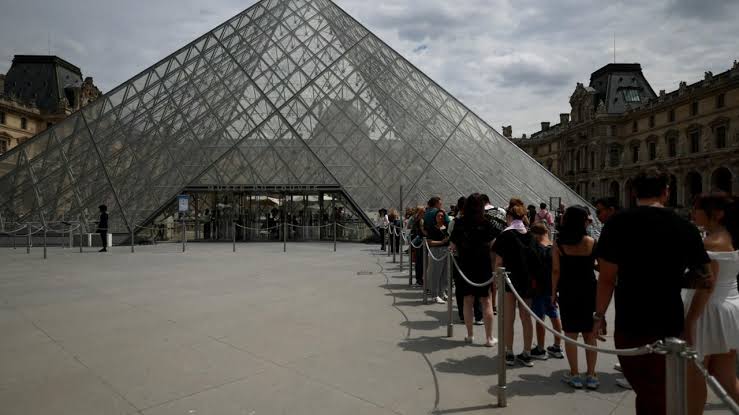
What is the future of the Louvre? The renowned museum in Paris has recently found itself at the center of a heated debate following the leak of a private memo from its director, Laurence des Cars, which outlined the building’s deteriorating condition.
In her communication to France’s culture minister, des Cars highlighted issues of damage, decay, and overcrowding.
Staff members have experienced these challenges firsthand. “We frequently encounter significant problems with water leaks from roofs and broken pipes,” states Élise Muller, a security guard at the Louvre and national secretary of the Sud Culture union.
“During heavy rainfall, water runoff can sometimes reach the displayed artworks. We are forced to close off rooms daily. Additionally, more elevators are becoming inoperable,” she notes. “Our concerns have consistently gone unaddressed.”
To manage the leaks, employees often resort to placing buckets in offices, according to Christian Galani, a representative for the museum’s CGT union and a member of its national board.
However, this measure is not always sufficient. “It is common for us to make emergency calls to conservationists to assist in removing artworks,” Muller adds.
Severe water leakage in 2023 led to the closure of an exhibition honoring French painter Claude Gillot, just four days after its inauguration.
Overcrowding
The Louvre, recognized as the largest museum in the world, was designed to handle 4 million visitors annually following extensive renovations completed under former president François Mitterrand’s “Grand Louvre” initiative from 1981 to 1993.
However, in 2024, the museum welcomed over 8.7 million visitors, more than double its intended capacity, with 80% of these being international tourists.
In response to the ongoing issues at the Louvre, President Emmanuel Macron promptly announced a visit to the museum on Tuesday, where he is anticipated to discuss its future.
“The Louvre represents France and embodies national pride. Ignoring the challenges facing the museum today would be a grave error,” his office stated on Friday.
This visit carries significant symbolism, as Macron has embraced the Louvre’s iconic status in the heart of Paris. In 2017, he celebrated his election victory in front of the museum’s glass pyramid.
There is also an element of irony in the presidential visit. The glass pyramid serves as the primary entrance for the thousands of visitors each day and is identified as a major congestion point, according to the museum’s director.
“We are facing a significant issue with overcrowding due to the layout of the reception area, which has adhered to the 1980s principle of a single entrance through the pyramid,” des Cars explained to France Info in 2023.
She recommended establishing an additional entrance at the museum’s westernmost point, adjacent to the Saint-Germain-l’Auxerrois church, to alleviate crowding. Additionally, she proposed the creation of a dedicated space for the Louvre’s most renowned artwork, the Mona Lisa, which attracts large crowds daily.
However, both initiatives would require funding, which remains a challenge despite the high visitor numbers and a general admission fee of €22.
Financial Concerns
Muller notes that the museum’s attempts to secure public funding for enhancements have been unsuccessful due to the current state of public finances.
France is grappling with a significant public deficit, which former Prime Minister Michel Barnier claims has led to necessary budget cuts amounting to €200 million. The current Prime Minister, François Bayrou, has yet to finalize the budget for 2025.
According to Galani, the Louvre’s provisional budget for 2025, presented to the Board of Directors in November, anticipates a decline of €52 million compared to the original 2024 budget.
The museum’s management refrained from providing additional comments ahead of Macron’s visit.
In the absence of public funding, the museum’s options for increasing revenue may hinge on either boosting sponsorship or raising admission fees.
Culture Minister Rachida Dati has chosen the latter approach, announcing on Thursday that a tiered ticketing system will be implemented in 2026, which will require visitors from outside the EU to pay more than the standard €22 entrance fee.
While the CGT has labeled the new system as “discriminatory,” Dati argues that it will “support the financing of this new museum project.”
Meanwhile, the Louvre’s staff remains uncertain about the implications of the president’s visit on Tuesday and whether it will lead to beneficial changes.
Having felt overlooked regarding their concerns about the museum’s condition, Muller worries that Macron may use the French cultural institution to enhance his public image, similar to criticisms surrounding his involvement in the restoration of Notre Dame Cathedral.
“I find his approach deplorable, as it suggests he is capitalizing on serious challenges,” she states.
Conversely, Galani expresses hope for more altruistic intentions. “I refuse to believe that the president’s visit is merely an attempt to salvage his image amid declining popularity. Our primary focus must be on the institution’s reputation, as the artworks will endure long after us,” he asserts.



